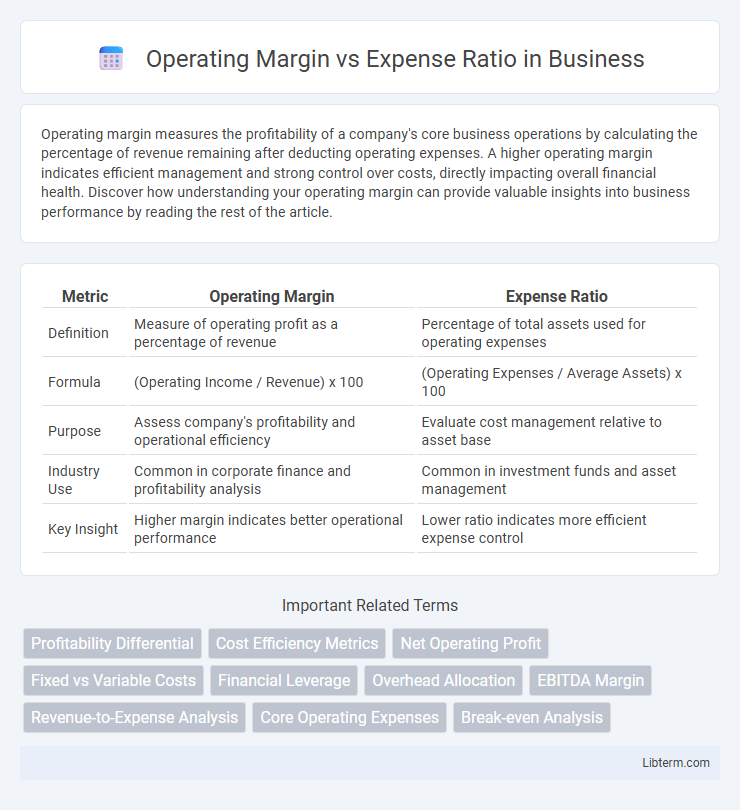Operating margin measures the profitability of a company's core business operations by calculating the percentage of revenue remaining after deducting operating expenses. A higher operating margin indicates efficient management and strong control over costs, directly impacting overall financial health. Discover how understanding your operating margin can provide valuable insights into business performance by reading the rest of the article.
Table of Comparison
| Metric | Operating Margin | Expense Ratio |
|---|---|---|
| Definition | Measure of operating profit as a percentage of revenue | Percentage of total assets used for operating expenses |
| Formula | (Operating Income / Revenue) x 100 | (Operating Expenses / Average Assets) x 100 |
| Purpose | Assess company's profitability and operational efficiency | Evaluate cost management relative to asset base |
| Industry Use | Common in corporate finance and profitability analysis | Common in investment funds and asset management |
| Key Insight | Higher margin indicates better operational performance | Lower ratio indicates more efficient expense control |
Introduction to Operating Margin and Expense Ratio
Operating margin measures a company's profitability by calculating the percentage of revenue remaining after covering operating expenses, reflecting operational efficiency. Expense ratio, often used in financial contexts such as mutual funds, represents the proportion of total expenses to assets under management or revenue, highlighting cost management. Understanding both metrics is crucial for evaluating financial health and operational performance in business analysis.
Defining Operating Margin
Operating margin is a key financial metric that measures a company's profitability by calculating the percentage of revenue remaining after covering operating expenses. It reflects the efficiency of a company's core business operations in generating profit before interest and taxes. A higher operating margin indicates better control over operating costs relative to revenue, providing valuable insight into operational performance compared to the expense ratio, which focuses solely on the proportion of operating expenses to total revenue.
Understanding Expense Ratio
Expense Ratio measures the percentage of a fund's assets used for operating expenses, including management fees, administrative costs, and other operational expenses, directly impacting the net returns to investors. Unlike Operating Margin, which reflects operating income relative to revenues and indicates profitability, Expense Ratio specifically quantifies ongoing cost efficiency in fund management. A lower Expense Ratio is crucial for investors seeking higher net returns and efficient fund operations over time.
Key Differences Between Operating Margin and Expense Ratio
Operating margin measures a company's profitability by comparing operating income to net sales, highlighting how efficiently a business generates profit from core operations. Expense ratio evaluates the proportion of total expenses to total revenue or assets, emphasizing cost control relative to income or investment size. Key differences include the focus on profitability versus cost efficiency and the calculation basis: operating margin uses operating income, whereas expense ratio centers on overall expenses.
Importance of Operating Margin in Business Analysis
Operating margin measures a company's profitability by calculating the percentage of revenue remaining after covering operating expenses, serving as a key indicator of operational efficiency and financial health. Unlike the expense ratio, which only tracks the proportion of expenses relative to revenue, operating margin provides a clearer picture of how well a business controls costs while generating profits. High operating margins signal strong management performance and competitive advantage, making it essential for investors and analysts to assess business sustainability and growth potential.
Significance of Expense Ratio for Investors
The expense ratio directly impacts the net returns investors receive from a fund, making it a critical metric for evaluating investment efficiency. A lower expense ratio indicates that a smaller portion of the fund's assets is consumed by operational costs, allowing more capital to be reinvested and potentially increasing overall profitability. Understanding the expense ratio helps investors compare funds with similar return profiles but differing cost structures to make more informed decisions.
Calculating Operating Margin and Expense Ratio
Operating margin is calculated by dividing operating income by net sales, indicating the percentage of revenue remaining after covering operating expenses. Expense ratio is determined by dividing total operating expenses by net sales, reflecting the proportion of revenue consumed by operating costs. Comparing these financial metrics helps assess a company's efficiency in managing expenses relative to its revenue.
Operating Margin vs Expense Ratio: Which Is More Insightful?
Operating Margin measures profitability by comparing operating income to total revenue, revealing how efficiently a company controls costs and generates profit from core operations. Expense Ratio focuses on operational costs relative to revenue, offering insight into cost management but not directly into profitability. Operating Margin provides a more comprehensive view of financial health, making it more insightful for assessing overall business performance.
Common Misconceptions and Pitfalls
Operating margin measures core profitability by comparing operating income to revenue, whereas expense ratio focuses on total operating expenses relative to assets or revenue. A common misconception is treating these metrics interchangeably; operating margin highlights profit efficiency, while expense ratio indicates cost management. Pitfalls include ignoring industry context and time periods, leading to misleading conclusions about financial health.
Conclusion: Choosing the Right Metric for Financial Evaluation
Operating margin provides a clear indication of profitability by measuring the percentage of revenue remaining after operating expenses, making it essential for assessing overall business efficiency. Expense ratio focuses more narrowly on cost control relative to revenue but may overlook profit generation capabilities. Selecting the appropriate metric depends on whether the financial evaluation prioritizes profitability or expense management, with operating margin preferred for profitability analysis and expense ratio for cost efficiency assessment.
Operating Margin Infographic

 libterm.com
libterm.com